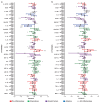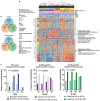Plasma concentration of injectable contraceptive correlates with reduced cervicovaginal growth factor expression in South African women
- PMID: 31896762
- PMCID: PMC7617771
- DOI: 10.1038/s41385-019-0249-y
Plasma concentration of injectable contraceptive correlates with reduced cervicovaginal growth factor expression in South African women
Abstract
Long-acting injectable contraceptives have been associated with mucosal immune changes and increased HIV acquisition, but studies have often been hampered by the inaccuracy of self-reported data, unknown timing of injection, and interactions with mucosal transmission co-factors. We used mass spectrometry to quantify the plasma concentrations of injectable contraceptives in women from the CAPRISA004 study (n = 664), with parallel quantification of 48 cytokines and >500 host proteins in cervicovaginal lavage. Higher DMPA levels were associated with reduced CVL concentrations of GCSF, MCSF, IL-16, CTACK, LIF, IL-1α, and SCGF-β in adjusted linear mixed models. Dose-dependent relationships between DMPA concentration and genital cytokines were frequently observed. Unsupervised clustering of host proteins by DMPA concentration suggest that women with low DMPA had increases in proteins associated with mucosal fluid function, growth factors, and keratinization. Although DMPA was not broadly pro-inflammatory, DMPA was associated with increased IP-10 in HSV-2 seropositive and older women. DMPA-cytokine associations frequently differed by vaginal microbiome; in non-Lactobacillus-dominant women, DMPA was associated with elevated IL-8, MCP-1, and IP-10 concentrations. These data confirm a direct, concentration-dependant effect of DMPA on functionally important immune factors within the vaginal compartment. The biological effects of DMPA may vary depending on age, HSV-2 status, and vaginal microbiome composition.
Conflict of interest statement
Figures




References
Publication types
MeSH terms
Substances
Grants and funding
LinkOut - more resources
Full Text Sources
Research Materials
Miscellaneous

